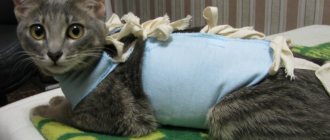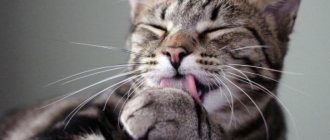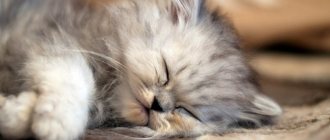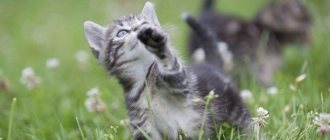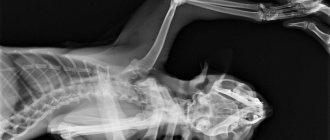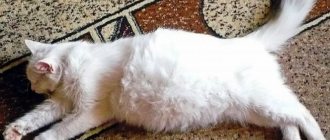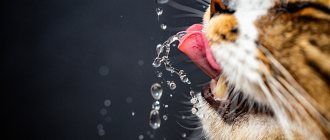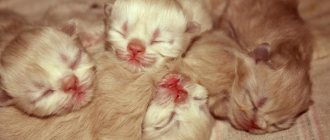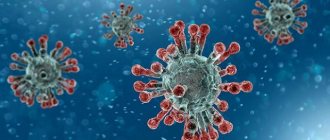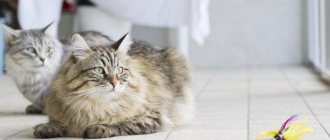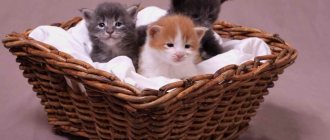People's passion for big, plump cats is inexplicable. Many people are moved by looking at photographs of giant fluffy balls, not realizing that the desire to fatten a cat to incredible sizes causes irreparable harm to his health. Some animals that received the title of “the fattest cat in the world” ended up on the pages of the Guinness Book of Records, although they later decided to remove this category due to fears that owners would deliberately overfeed their pets in order to receive this title.
Criteria for normal weight of cats and kittens
First of all, 3 factors influence a cat’s weight: its breed, age and lifestyle. For this reason, veterinarians do not recommend relying on a single standard. The norm calculated for a specific pet is much more reliable.
Breed affiliation
On average, domestic cats weigh 3.6-4.5 kg, but, depending on the breed, this figure freely “walks” up or down. For example, Maine Coons will always be larger than short-legged Munchkins, even at the kitten stage.
The constitution of the body is no less important. The norms for the “British” and “Scots” are practically the same, but the former are characterized by more developed muscles, and the latter by graceful proportions.
Differences are also observed within the breed. Most felines are characterized by pronounced sexual dimorphism. This means that a male can always be distinguished from a female thanks to the extra pounds. In most cases the difference is 1-2 kg.
Age
A cat's weight constantly changes as it grows. The minimum indicator is typical for kittens, but they gain new kilograms much faster and practically do not store fat.
By 1.5-2 years, weight stabilizes, and its deviation becomes undesirable. Older animals most often suffer from obesity and exhaustion, as metabolism slows down with age and the number of chronic diseases increases.
Nutrition and activity
Weight is affected not only by the amount of food eaten, but also by the quality of food and the frequency of meals. For this reason, homeless animals are more likely to suffer from thinness. In addition to irregular and meager nutrition, their lives are marked by excessive activity. Street cats are constantly in search of food and are forced to regularly defend their territory.
Pets live in maximum comfort. Their activity level depends on the efforts of the owners, breed and age. The main fans of games are the “Abyssinians” and “Orientals”, and the main admirers of the sofa lifestyle are the “British” and “Persians”. Because of this, the latter are more likely than others to suffer from obesity.
Famous fat bellies
You can now see a lot of fat cats on the Internet, which often become the objects of jokes and memes. And this is almost always the fault of people who do not monitor how much the cat eats and how balanced its diet is. And the poor animal just gets fatter and fatter.
Elvis the cat
Elvis
Elvis, from Clydebank, Scotland, who had free access to food every day, ended up gaining 10kg, roughly doubling his normal weight. His owner, 55-year-old Carol Sweeney, never gave Elvis human food, but did not monitor his portion sizes. He could eat at any time of the day, and as soon as his plate was empty, the hostess immediately filled it. And very quickly Elvis gained weight. But the owner still realized that such dimensions were not normal for her pet, and after consultations with veterinarians, they switched the cat to a special diet and began to carefully weigh its portions.
Mr. Pickles
Mr. Pickles at the shelter
A stray fat cat named Mr. Pickles is one of the biggest ones rescued by the staff of the Scottish shelter. Three-year-old Mr Pickles was found in Balmedi. He was taken to the SSPCA (Scottish Society for the Prevention of Cruelty to Animals) Animal Rescue and Relocation Center in Drumoak. At that time his weight was 11.5 kg. A local charity immediately enrolled him in a weight loss and exercise program.
This giant is incredibly friendly. He loves having his belly rubbed and happily lies on his back with all four paws dangling in the air. Mr. Pickles was left in the care of veterinarians for quite some time, allowing him to gradually lose weight. This program included diet and exercise. He needed to lose weight to the ideal 5-6 kg.
Veterinarians were waiting for the cat to lose a little weight so that after that they could carry out the necessary examinations and find out whether obesity was harming his health. Only after Mr. Pickles reaches an appropriate weight will he be looked for a loving home who can continue with his diet and exercise plan.
Fat Thule
Tulle with Tabitha
This cute, fat guy from Denmark became one of the first internet phenomena to gain popularity in 2002 due to his enormous weight. Although many internet users assumed that Thule's photos were just photoshopped, he really was that fat and weighed about 19.2 kg. As a result of his obesity, Tulle developed kidney problems and diabetes, which forced him to euthanize the fattest cat on the planet at the time in early 2008. Due to excess weight, the cat could not walk independently and was constantly carried in arms. He even had his own blog, where they posted photos of him with 12-year-old Tabitha Pedersen.
Despite the fact that Tulle died due to complications caused by excess weight, looking at him, people began to post photos of obese cats online in large numbers; some of them may have been deliberately overfed by humans to out-compete Thule.
How to visually understand that your pet has a normal weight
A cat's normal weight can be easily determined by its proportions. In the absence of deviations, the animal’s body corresponds to the following indicators:
- clearly defined waist;
- a toned stomach with a thin layer of fat;
- poorly visible ribs and pelvis that can be palpated.
A predominance of muscle mass over fat is also recommended. It is easy to identify in short-haired representatives due to its more pronounced relief.
Well-fed Elvis
Another fat cat lives in Germany. His name is Elvis and he weighs 17.5 kg. Unlike some well-fed, but luckier relatives, the German fatty has health problems. He was diagnosed with diabetes, which developed due to obesity. The pet moves very little, because after a few steps it becomes difficult for him to bear such a large weight.
The cat's owners are currently trying their best to help him cope with excess weight. Elvis is given insulin injections twice a day and has also been prescribed a special diet to lose weight. They say that with the help of thoughtful nutrition, the gray and white cat got rid of 1 kilogram and continues to lose weight.
Now Elvis is considered “the fattest cat in Germany.” But according to the volunteers who took care of the animal’s health, this cat may receive the title of “the fattest cat in the world.” His weight, even after losing weight, remains greater than that of the cat, which is now recorded as “the fattest in the world” in the Guinness Book of Records.
Normal development of kittens of different breeds
At birth, most kittens weigh between 70-130 g. Maximum weight gain is observed in the first month of life. The average daily gain is 15 g, so by 4 weeks after birth many animals reach 500 g.
You can see detailed changes in body weight from 1 to 12 months in different breeds in the table below.
| Breed | Weight by month (kg) | ||||||
| 1 | 2 | 3-4 | 4-6 | 6-8 | 8-10 | 10-12 | |
| British | 0,56-0,83 | 1,15-1,6 | 1,7-4 | 2,65-5,6 | 3,6-6 | 4-7 | 4,2-8 |
| Scottish | 0,25-0,75 | 0,42-1,8 | 1-3,9 | 2,2-5,5 | 2,3-6,1 | 2,6-6,6 | 2,6-7 |
| Maine Coon | 0,55-0,75 | 1,1-1,6 | 1,6-4 | 2,9-6 | 3,2-7 | 3,8-7,3 | 4-8,7 |
| Don Sphynx | 0,2-0,4 | 0,5-0,8 | 1-3 | 1,3-3,6 | 2,2-5,1 | 2,8-5,7 | 3,2-6,4 |
| Canadian Sphynx | 0,4-0,65 | 0,9-1,3 | 1,5-2,5 | 1,9-3 | 2,6-4,4 | 3,1-4,8 | 3,4-6,8 |
| Persian | 0,37-0,5 | 0,6-1 | 0,95-2,2 | 1,4-3,6 | 2,3-4,3 | 2,8-5,6 | 3,5-6,2 |
| Siamese | 0,23-0,7 | 0,52-1,6 | 1-3,3 | 1,2-4,1 | 1,7-4,6 | 2-5,1 | 2,3-5,6 |
| Siberian | 0,35-0,74 | 0,59-1,45 | 1-4 | 1,6-5,1 | 2,7-5,8 | 3-6,2 | 3,5-7 |
| Russian blue | 0,25-0,74 | 0,45-1,7 | 1-3,9 | 1,7-4,9 | 2,3-5,3 | 2,5-5,5 | 2,5-5,8 |
| Abyssinian | 0,3-0,8 | 0,55-1,5 | 1-3,7 | 1,5-4,5 | 2-5 | 2,3-6 | 2,5-7,5 |
| Ragdoll | 0,28-0,71 | 0,49-1,47 | 1,2-3,67 | 1,7-5,69 | 2,5-6,3 | 3-7,2 | 3,3-7,7 |
| Exotic | 0,25-0,77 | 0,47-1,55 | 1,2-3,5 | 1,7-4,7 | 2,1-5,2 | 2,4-5,7 | 2,8-6,2 |
| Bengal | 0,35-0,56 | 0,64-1,3 | 1,2-3 | 1,7-4,3 | 2,8-5,1 | 3,2-5,6 | 3,3-6,3 |
The table shows that after reaching six months, the rate of weight gain slows down. At this stage, puberty occurs. After this, the weight gain is less significant.
The difference between males and females is also clearly visible, but at first there may be slight deviations within the litter. That is, some girls may be ahead of boys due to a more balanced diet. It may be related to the total number of newborns (lack of nipples) and the degree of milk production of the recently given birth pet.
Separately, we should consider the developmental features of outbred kittens and mixed-breed kittens. First, let's outline their differences:
- Mongrels (outbred). Obtained through uncontrolled and most often natural mating. They do not have documents due to the unknown breed of their parents. They can be born as a result of mating of mixed breeds or other mongrels. In this case, the maximum mixture of a wide variety of breeds can be seen.
- Metis. Obtained by mating animals belonging to different breeds. They do not have documents due to the unofficial nature of such matings. They have more predictable behavior and appearance.
Due to the peculiarities of birth, the norm for mongrels and mixed breeds is very different from general standards. A pet born not according to the rules of selection can take traits from both parents at once. As a result, even here the most reliable method remains visual inspection.
It is important about the health of the wards
Today, in many developed countries, special attention is paid to the protection of animals, as well as control of their keeping at home. For neglect, abuse and failure to fulfill obligations to care for animals, the guilty owners face heavy fines, and in some especially serious cases, even imprisonment.
One of the main aspects of a pet’s well-being and health is proper nutrition, a balanced diet and physical activity.
Therefore, it is very important not to overfeed, not to self-medicate, and to take medications, especially hormonal ones, only under the supervision of a veterinarian
Beginning in 1998 (some sources say 2003), representatives of the Guinness Book of Records officially stopped accepting applications for setting any animal records related to their diet, weight and food consumption. It is believed that this can cause significant damage to the health of the animal, since some owners deliberately overfeed them in order to get the coveted victory in the nomination.
All domestic cats found in urban areas and beyond have common roots. They are believed to be a subspecies of the forest cat, domesticated 10,000 years ago. According to statistics, there are 600 million domestic cats in the world today, and each of them belongs to 1 of 256 breeds.
Over a period of thousands of years, each breed has acquired individual traits and parameters that a person can easily navigate when choosing a pet. Cats differ not only in appearance, each has its own individual temperament and even a tendency to hereditary diseases that is passed on to the offspring. These characteristics make up the calling card of each breed.
Below is information about the largest cat breeds, the star cat Omar and the humane ban on one of the cat nominations in the Guinness Book of Records.
How much should an adult cat weigh: table by age and breed
As noted above, weight gain continues until approximately 1.5-2 years. From this moment on, it stabilizes, so the owner can simply hold it.
The table below shows the weight norms for male cats by age and breed.
| Breed | Weight, kg) | |
| Males from 1.5 to 8 years | Females from 1.5 to 8 years | |
| British | 5-8 | 3-6 |
| Scottish | 4-7 | 3-5 |
| Maine Coon | 8-12 | 4,6-7,5 |
| Don Sphynx | 5-7 | 3,5-4 |
| Canadian Sphynx | 5-7 | 3,5-4 |
| Persian | 4-6,2 | 3-5 |
| Siamese | 4-5,6 | 3-4 |
| Siberian | 6-9 | 3,5-7 |
| Russian blue | 3,5-5,8 | 3-4 |
| Abyssinian | 4-7,5 | 3-4,5 |
| Ragdoll | 7-10 | 4-6 |
| Exotic | 4-6,2 | 3-5 |
| Bengal | 5-7 | 3,5-4,5 |
When the animal reaches 8 years of age, it is classified as elderly. The processes in his body slow down. Most of what you eat is stored as fat, and due to reduced activity, muscle mass noticeably decreases. As a result, a pet that meets the above standards may look much more well-fed. This is due to the fact that fat is always lighter than muscle. This feature of the body once again confirms the advisability of a visual inspection.
It is also worth mentioning the relationship with castration and sterilization. After surgery, animals often weigh more than normal. The reasons here are the same as with aging: a slowdown in metabolism and a decrease in usual activity.
Tulle
Nine-year-old Tulle has surpassed previous participants in the ranking of fat cats. The red-haired pet, which has gained 20 kg, lives in Denmark.
A cat, when it lies motionless, can be confused with a small fluffy pillow or ottoman. The owners cannot refuse the cute little cat his constant desire to eat something tasty. Over time, Tulle lost interest in outdoor games and indulged in laziness. It is difficult for the cat to walk, and in order not to get up, he has learned to roll like a ball, and in this way he gets to the bowl of food. Of all the activities, Tulle chooses sleep.
Currently, the hero is following a diet, because his weight is approaching a critical point.
Deviations from normal weight in cats and kittens - and what the owner should do
The average weight of an adult cat should not deviate significantly up or down. In the first case, there is a risk of obesity, and in the second - exhaustion. In addition to the number on the scale, the appearance and behavior of the animal can tell about these problems.
Obesity
With excess body weight, the cat becomes as passive and lazy as possible. She is reluctant to play with toys and lies on the sofa almost all the time, as it becomes difficult for her to move. She can no longer jump high. When examining the body, you may notice the following changes:
- the appearance of clearly visible fat deposits on the stomach, back and face;
- loss of a pronounced waist and bone line;
- difficulty or impossibility of palpating the ribs and pelvis due to fat.
To get rid of extra pounds, it is recommended to reduce the volume of the daily portion and increase the activity time with the help of various teasers, game complexes and interactive toys.
If the animal does not eat enough and constantly begs, increase the number of feedings without increasing the total calorie content. Many pets simply do not feel full, so you should not rely on their hungry eyes with a waist that is far from a wasp.
Exhaustion
If your cat's weight has dropped below the recommended norm, be sure to confirm possible malnutrition with a visual inspection. The need for urgent weight gain can be determined by the following signs:
- a pronounced line of rib and pelvic bones, appearing directly through the skin;
- a small number of muscles and a protruding spine;
- lack of subcutaneous fat on a strongly sunken tummy.
The most common cause of exhaustion is nutritional problems. This includes low calorie content, an unbalanced diet and a discrepancy with the animal’s taste preferences. In the first case, there is a lack of calories, in the second, a lack of proteins and fats, and in the third, a banal refusal to eat.
To eliminate body weight deficiency, you need to act based on the situation:
- Review the daily serving amount. The norms for dry food can be found on the packaging, but when feeding “natural” it is better to use a special formula.
- Namely: adjust the ratio of proteins, fats and carbohydrates. Their percentage ratio should be 52:36:12.
- Choose food that is more attractive to your pet. Don't rush to change brands. Chances are that your pet just doesn't like the taste of chicken.
If your pet eats dry kibble, then it makes sense to look for a special line of food with a high calorie content. It will make it easier to gain kilograms and eliminate the lack of substances important for the cat’s body.
When you need veterinary help
You should contact your veterinarian if you are severely obese or malnourished. Both cases are fraught with quite serious complications and are often associated with concomitant diseases (endocrine, cardiovascular). The following symptoms will help you find out about the pathology:
- lethargy and apathy;
- change in appetite (deterioration or perversion);
- frequent vomiting;
- bowel dysfunction, including changes in the color, shape and consistency of stool;
- unpleasant odor from the mouth;
- increase or decrease in temperature;
- increased salivation;
- excessive tearing or suppuration of the eyes;
- yellowing or blue discoloration of mucous membranes.
If the disease is confirmed, the animal will require specific treatment. In addition, the doctor will help you choose a special diet with low or high calorie content.
The heaviest cat in the world - Himmy
The owner of the cat was Australian Thomas Vyse. The weight of the heaviest cat in the world was 21.3 kilograms, the owner drove him in a wheelbarrow around his garden plot. When the animal was measured, it turned out that it was 96.52 centimeters long, almost a meter! Himmi's waist circumference was 83.82 centimeters, and her neck – 38.1 centimeters. For comparison, the norm for an adult man is a neck circumference of about 38.8 centimeters!
The cat did not move well on his own, was extremely lazy and loved to eat. This led to excess weight. Unfortunately, the cat died at the age of 10 from respiratory failure. Apparently, Himmi suffered from heart failure due to his obesity. He left his owner on March 12, 1986. It was after this that this category was closed in the Guinness Book of Records.
Few people know that the record holder had a predecessor. There is more than one heaviest cat in the world in the Guinness Book of Records. There are only two of them!
Everyone knows about Himmy, but before him, the title of heaviest cat was held by the cat Spicy, who lived in Connecticut. Her weight was 20 kilograms, and she died in 1977.
How to weigh your pet correctly
You can find out how much a cat weighs at a veterinarian's appointment or right at home. In the second case, you will need electronic scales. Mechanical ones are suitable only for the calmest pets. In other cases, the arrow will constantly jump, not having time to lock on.
The most reliable option is to weigh it in your hands, but you can also put the animal in some kind of container or secure it in a bag. In the first case, it will be necessary to subtract your own weight from the resulting figure, and in all others, a lot of additional devices.
SpongeBob
In 2012, the Guinness Book of Records entered a new record - the fattest cat in the world was determined. It turned out to be a red-haired pet with an interesting nickname SpongeBob. Its weight is 15.5 kg, which is approximately equal to the weight of a four-year-old baby.
The cat ended up in a New York cattery, where he surprised the entire staff with his weight. The animal underwent a full examination to exclude the possibility of diseases. And it turned out that the cat was completely healthy.
True, the nursery staff are sure that excess weight is not the norm for a 9-year-old cat. And they try to help him get rid of the extra pounds through a special diet and special exercises. Veterinarians expect that losing excess weight will allow the cat to move normally.
Watson
A very fat cat was brought to one of the British shelters. He weighed more than 15 kg. The owners fed the cat uncontrollably and did not force him to move, which is why he gained excess weight.
Obesity prevented the animal from living a normal life; he could not use the litter box normally. According to shelter employees, the cat looked very sad and shy.
Sheila, the director of the shelter, began a program to rescue the chubby cat. First of all, she changed the cat’s old name, Fatty, to a new one: Watson. The cat was put on a strict diet: he received no more than 70 g of low-calorie food at a time.
Sheila chose a very correct tactic for treating gluttony. The cat was not forced to move until the strict diet bore fruit. A year later, Watson began to show interest in the area around him. He often played, although lying down.
The cat was diagnosed with benign tumors and underwent surgery. Timely weight loss allowed the use of anesthesia. After the operation, Watson became an even more active cat:
At first he could jump on the sofa, and later on the windowsill, which he was extremely proud of.
The cat managed to reach a normal weight of 7 kg, which allows him to lead a normal cat life. Thanks to Sheila's competent approach to the cat's diet and gradual physical activity, Watson was able to lose weight without risk to the cardiovascular system.
The fattest cats in the world are an example of the irresponsibility of people. Improper care, excessive feeding and reluctance to take care of the pet lead to obesity in animals.
This condition causes serious problems and diseases in four-legged animals. Once in the hands of animal rights activists, fat cats receive the right treatment and diet that helps them return to normal life.
A unique selection of news from our editor-in-chief
Source
Handsome Pikkis
The next representative of fat cats lives in Helsinki. He may well be the next contender for the title of fattest. His name is Bond, but his owners prefer to call him by his charming nickname Pikkis, which literally translates as Baby.
The cat weighs 16 kg and is 120 cm long, which is not at all surprising, since the animal belongs to the Maine Coon breed. This breed is considered the largest in the world, but even for its representatives, a weight of 16 kg is rare.
